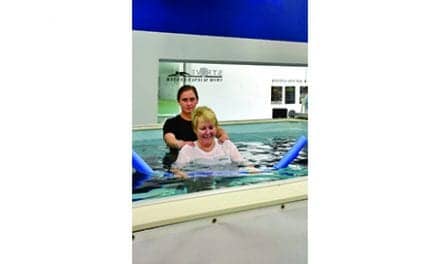Physiotherapy is beneficial in patients with ankylosing spondylitis, and while more research is needed, expanding traditional exercise programs to include aerobic and cardiorespiratory components along with patient education may improve outcomes for patients with non-radiographic axial spondyloarthritis as well, according to a study in Rheumatology and Therapy.
“Helping rheumatologists and other physicians who treat patients with axial spondyloarthritis to know the benefits and limitations of exercise and to prescribe it, with educational sessions, could be useful to better manage patients,” writes Fabio Perrotta, from the Universita Degli Studi del Molise in Campobasso, Italy, who conducted the study.
Axial spondyloarthritis is a group of inflammatory conditions typically affecting the spine and characterized by the presence of back pain caused by enthesitis of the sacroiliac joints and sometimes extra-articular sites as well. The two major forms of spondyloarthritis are ankylosing spondylitis and non-radiographic axial spondyloarthritis with both leading to significant pain and mobility issues that are progressive.
Biologic drugs such as anti-tumor necrosis factor and anti-interleukin medications have dramatically improved the quality of life and prognosis for patients with axial spondyloarthritis. However, the needs of non-responders remain unmet. Even with new treatments, physical therapy and rehabilitation remain crucial in the management of axial spondyloarthritis.
The authors conducted a review of the current literature in an effort to produce this concise review examining the role of physical therapy and rehabilitation in both ankylosing spondylitis and non-radiographic axial spondyloarthritis, a media release from Rheumatology Network explains.
When a patient with axial spondyloarthritis presents to a clinician, they should be assessed for disease activity, workability, pain, function, psychological impact, and overall quality of life. Patient functioning, disability and disease activity can be quantified by the multitude of scales and measures recommended by the international rheumatologic community, allowing clinicians to risk stratify and treat patients with spondyloarthritis appropriately.
When physiotherapy is undertaken for axial spondyloarthritis, supervised outpatient exercise programs have been shown to reduce the burden of pain and stiffness. Inactivity has been linked to more pain and psychological depression. Rheumatologists consider regular exercise to be a key component in the management of axial spondyloarthritis.
Recent evidence suggests that physiotherapy initiated early is beneficial for both ankylosing spondylitis and non-radiographic axial spondyloarthritis. While exercise improved global disease activity in both conditions, overall quality of life did not change for these patients. Evidence is sparse, however, and more research is needed to determine if exercise improves function, reduces pain, and or enhances quality of life over the long term in patients with non-radiographic axial spondyloarthritis, the release continues.
With regards to ankylosing spondylitis, good evidence exists showing the positive effects of physical exercise in the control of disease activity, pain, mobility, function and quality of life.
When a combination of pharmacological and rehabilitation therapy was examined, anti-tumor necrosis factor treatment plus physiotherapy was associated with improvements in function, disability, and quality of life in ankylosing spondylitis when compared to either drug treatment or exercise alone. In addition to improvement in quantitative measures, exercise and medication together led to improvements in patient-perceived stiffness, function, fitness, and overall well-being.
While cardiorespiratory exercise improved fitness in patients with axial spondyloarthritis, it had no real effect on disease activity, quality of life or spinal mobility; however, improvements in overall fitness may have beneficial effects on other comorbidities.
Educating patients about exercise and axial spondyloarthritis is crucial for successful treatment. Education and monitored group exercise programs leads to improvements in disease activity, quality of life and spinal mobility, per the release.
Many patients may be afraid that activity will worsen their pain or even damage their bodies. Clinicians should reassure patients with ankylosing spondylitis who may be afraid to engage in exercise that it is safe.
Patients should be selected on a case-by-case basis since baseline mobility and comorbidities may limit the type and intensity of exercise they can participate in. Clinicians should strive to educate patients with axial spondyloarthritis that adherence to prescribed medication along with monitored exercise is likely to reduce their pain and improve their function more than simply taking the medication alone, the release concludes.
[Source: Rheumatology Network]





